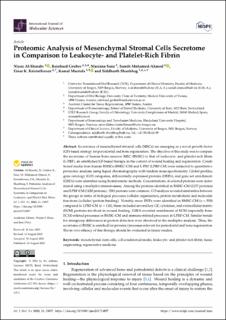| dc.contributor.author | Al-Sharabi, Niyaz Abdulbaqi Abdulmajid | |
| dc.contributor.author | Gruber, Reinhard | |
| dc.contributor.author | Sanz, Mariano | |
| dc.contributor.author | Mohamed-Ahmed, Samih Salah Eldin Mahgoub | |
| dc.contributor.author | Kristoffersen, Einar Klæboe | |
| dc.contributor.author | Mustafa, Kamal Babikeir Elnour | |
| dc.contributor.author | Shanbhag, Siddharth | |
| dc.date.accessioned | 2024-03-19T10:11:05Z | |
| dc.date.available | 2024-03-19T10:11:05Z | |
| dc.date.created | 2023-09-07T12:55:29Z | |
| dc.date.issued | 2023 | |
| dc.identifier.issn | 1661-6596 | |
| dc.identifier.uri | https://hdl.handle.net/11250/3123061 | |
| dc.description.abstract | Secretomes of mesenchymal stromal cells (MSCs) are emerging as a novel growth factor (GF)-based strategy for periodontal and bone regeneration. The objective of this study was to compare the secretome of human bone marrow MSC (BMSC) to that of leukocyte- and platelet-rich fibrin (L-PRF), an established GF-based therapy, in the context of wound healing and regeneration. Conditioned media from human BMSCs (BMSC-CM) and L-PRF (LPRF-CM) were subjected to quantitative proteomic analysis using liquid chromatography with tandem mass spectrometry. Global profiles, gene ontology (GO) categories, differentially expressed proteins (DEPs), and gene set enrichment (GSEA) were identified using bioinformatic methods. Concentrations of selected proteins were determined using a multiplex immunoassay. Among the proteins identified in BMSC-CM (2157 proteins) and LPRF-CM (1420 proteins), 1283 proteins were common. GO analysis revealed similarities between the groups in terms of biological processes (cellular organization, protein metabolism) and molecular functions (cellular/protein-binding). Notably, more DEPs were identified in BMSC-CM (n = 550) compared to LPRF-CM (n = 118); these included several key GF, cytokines, and extracellular matrix (ECM) proteins involved in wound healing. GSEA revealed enrichment of ECM (especially bone ECM)-related processes in BMSC-CM and immune-related processes in LPRF-CM. Similar trends for intergroup differences in protein detection were observed in the multiplex analysis. Thus, the secretome of BMSC is enriched for proteins/processes relevant for periodontal and bone regeneration. The in vivo efficacy of this therapy should be evaluated in future studies. | en_US |
| dc.language.iso | eng | en_US |
| dc.publisher | MDPI | en_US |
| dc.rights | Navngivelse 4.0 Internasjonal | * |
| dc.rights.uri | http://creativecommons.org/licenses/by/4.0/deed.no | * |
| dc.title | Proteomic Analysis of Mesenchymal Stromal Cells Secretome in Comparison to Leukocyte- and Platelet-Rich Fibrin | en_US |
| dc.type | Journal article | en_US |
| dc.type | Peer reviewed | en_US |
| dc.description.version | publishedVersion | en_US |
| dc.rights.holder | Copyright 2023 The Author(s) | en_US |
| dc.source.articlenumber | 13057 | en_US |
| cristin.ispublished | true | |
| cristin.fulltext | original | |
| cristin.qualitycode | 1 | |
| dc.identifier.doi | 10.3390/ijms241713057 | |
| dc.identifier.cristin | 2173224 | |
| dc.source.journal | International Journal of Molecular Sciences | en_US |
| dc.identifier.citation | International Journal of Molecular Sciences. 2023, 24 (17), 13057. | en_US |
| dc.source.volume | 24 | en_US |
| dc.source.issue | 17 | en_US |

